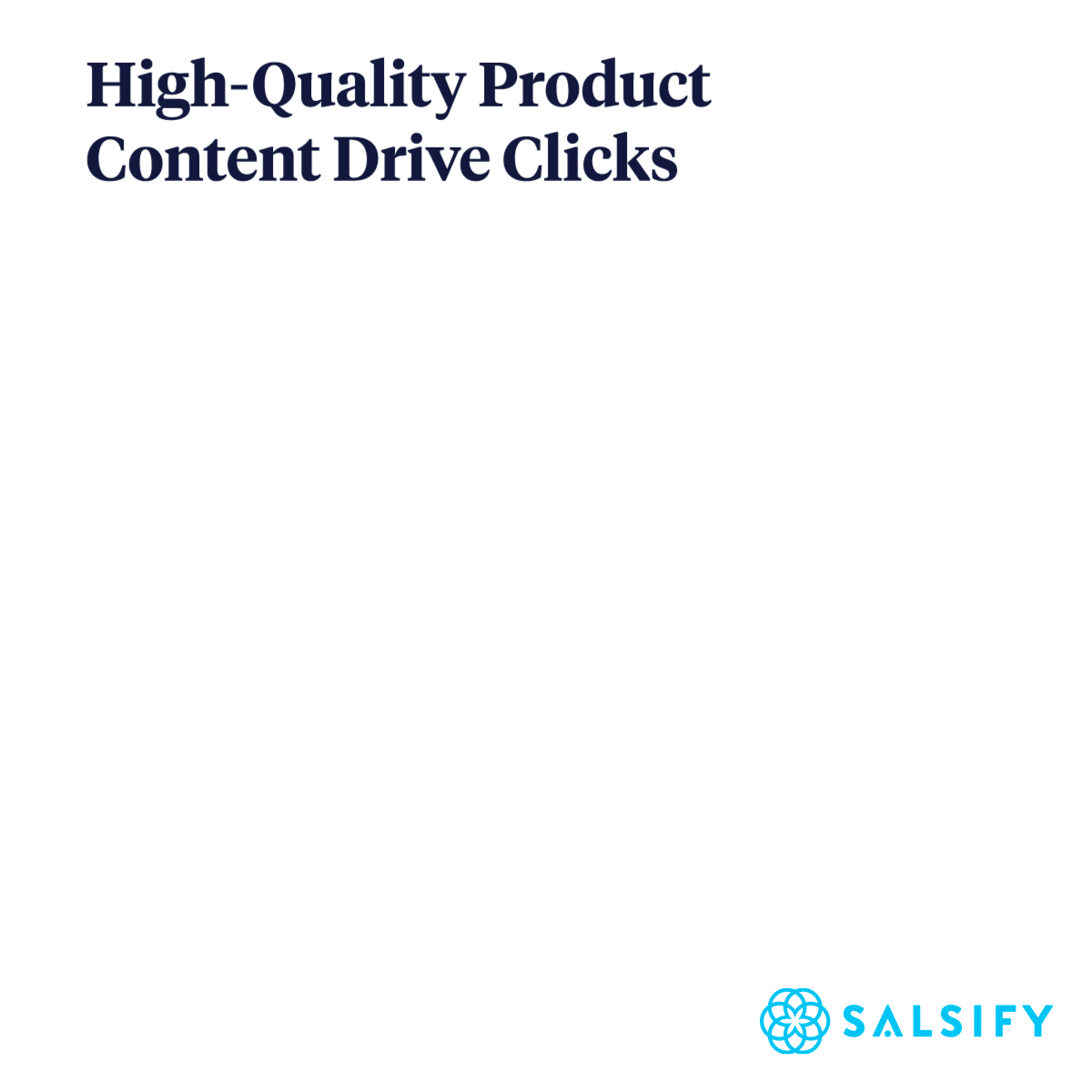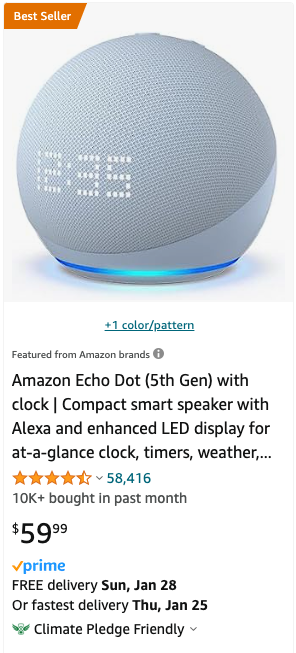High-Converting Product Pages: How To Drive Clicks From Search

The “2024 Consumer Research” report from Salsify revealed that 49% of online shoppers start their journey via a search engine. Once shoppers click search, they’re inundated with hundreds if not thousands of potential products — like a kid in a candy shop, to put it lightly.
The sheer competition means it’s more difficult than ever to stand out in the search engine results pages (SERPs), but there are ways you can make your listing the most appealing on the page.
This post explores first-hand data on what kind of content drives the most clicks from organic searches for high-converting product pages.
Why Ecommerce Search Engine Optimization (SEO) Is So Important
Salsify’s “2024 Consumer Research” report found that 23% of people shop online multiple times a week and 10% shop online daily. There’s plenty of opportunity to get in front of the right shoppers — but you have to go about it the right way.
This is particularly true when you consider that 45% of searchers only review results up to page three, and 14% only review results on the first page of Google.
To capture high-intent shoppers, you have to be as close to the top of the SERPs as possible. This is where ecommerce search engine optimization (SEO) comes into play. Optimizing on-page content to include relevant keywords and engaging elements is critical for ensuring your product pages appear at the top of the search results.
But just making it to the top isn’t enough if shoppers aren’t compelled to click through. Salsify’s report revealed several important factors for driving clicks, including high-quality product images and high star ratings.
7 Product Content Elements That Drive Clicks From Search
The competition in the SERPs is fierce. If you search for something like “long black coat” in Google, you’re instantly served millions of results (3.5 billion, to be more precise). That’s a lot of results to parse through, which is why most shoppers have a set of criteria they use to decide whether a listing is worth clicking into or not.

Source: 2024 Consumer Research
These were the most important elements from 2024 Consumer Research:
1. High-quality product images: 44% very important, 32% extremely important
2. Clear and compelling product titles: 37% very important, 20% extremely important
3. High customer ratings: 36% very important, 36% extremely important
4. Pricing and discounts: 37% very important, 39% extremely important
5. Free or fast shipping options: 36% very important, 32% extremely important
6. Social proof icons: 17% very important, 11% extremely important
7. Sponsored brand or product ads: 14% very important, 8% extremely important
1. High-Quality Product Images
According to Online Dasher, a consumer research resource, 75% of online shoppers rely on product photos to make purchasing decisions — and this reliance starts way before product pages and checkouts. It starts in the search results.
Google was traditionally a text-based search engine. When it started adding visuals to the results pages, searchers had a new way of deciding whether to click through. Now, most commercial searches trigger a shopping search, which means Google shares a handful of relevant Google Shopping posts with their accompanying pictures.
Here’s how to make sure your product images stand out:
- Use high-resolution images;
- Make sure the photo shows your product in full;
- Avoid busy backgrounds; and
- Use good lighting and contrast.
Image Source: Amazon
2. Clear and Compelling Product Titles
Shoppers want to know what they’re clicking through for, and product titles give them that information. The clearer you can be with your titles, the better. Including accurate details in your titles will attract high-intent shoppers and help Google better match your product to the initial search query. According to Data Feed Watch, optimizing your product titles and descriptions can lead to a 250% increase in clicks and a 93.65% higher conversion rate.
So, how do you fully optimize your product titles?
- Use the most relevant keywords at the start of your title;
- Include as much descriptive information as possible, including color, size, style, and material;
- Use words your audience is likely to use;
- Avoid capital letters and exclamation marks; and
- Maximize the 150 characters you have available.
3. High Customer Ratings
Research by Search Engine Land found that customer reviews can improve click-through rates by up to 35% in the SERPs. Shoppers want reassurance and star ratings build searcher trust with a visual representation of social proof.
But customer ratings aren’t just a way to prove your brand in the search results. They can also help your listings stand out in the search results with an added element. Take a look at these results, for example. The Oreo listing stands out more due to the combination of imagery and a high volume of top ratings.
Image Source: Amazon
4. Pricing and Discounts
Everyone loves a bargain, there’s no doubt about that. But adding a price or a discount to your product page listing can be the difference between someone clicking through or scrolling past.
Google knows how important pricing is for shoppers, which is why it recently launched its pricing insights feature in the search results. This allows shoppers to get insights into the price history of an item and get an overview of the general pricing trends when they search for a product.
If you want to generate click-throughs from search, make sure your prices are competitive because there’s no hiding them now. Research what competitors are selling for and find the sweet spot.
5. Free or Fast Shipping Options
Shipping can make or break a purchasing decision. According to warehousing and order fulfillment provider Meteor Space, 73.6% of shoppers believe delivery is the most important aspect of the overall customer experience. Highlighting your shipping options — especially if they’re free or fast — can drive clicks because shoppers want to know when they’re going to have the product in their hands.
Shoppers are so set on fast delivery that they’re willing to pay extra for it. Research by delivery service Flash Box revealed that 88% of consumers are willing to pay for same-day delivery and 62% consider it a key factor when making a purchase.
6. Social Proof Icons
Shoppers want to know they’re buying the best of the best. Adding social proof icons, like bestsellers or top-rated badges, reassure consumers that many others have successfully bought the product before them. This is particularly important if you’re listing your products on sites like Amazon that rank bestsellers and top-rated products higher in the search results.
This wireless alarm clock has the added social proof of a bestseller badge on Amazon, which makes it stand out among other similar products.

Image Source: Amazon
7. Sponsored Brand or Product Ads
Sponsored brands and product ads are automatically bumped to the top of the search results, which means they get more action than listings further down. Although shoppers don’t consider this element as important as high-quality images, social proof, or pricing information, it still plays a part in their shopping journey.
Sponsored ads at the top of Google get 2.1% of click-throughs compared to 67% of click-throughs generated from the first three organic results (as noted by SEO agency First Page Sage), but that’s still more than listings that are much further down the first, second, or third pages.
Drive Click-Throughs With High-Converting Product Pages
The competition in the search results is fierce — regardless of whether that’s on Amazon or Google. For high-converting product pages, you need to optimize your product content so it includes all the elements shoppers look for.
This includes high-quality photos, clear and compelling product titles, customer ratings, pricing information, and shipping options. The more information you can provide shoppers with, the higher your chances are of increasing conversions via the search results.
Top-Performing Content Explained
Explore the "2024 Consumer Research" report to find out more about why shoppers engage with some content and forget the rest.
VIEW REPORTWritten by: Lizzie Davey
Lizzie Davey (she/her) is a freelance writer and content strategist for ecommerce software brands. Over the past 10 years, she's worked with top industry brands to bring their vision to life and build optimized and engaging content calendars.
Recent Posts
Ecommerce Marketing
|
12 minute read
The Art of the Impulse Buy: 70% of Shoppers Say Discounts Drive Unplanned Purchases — Here’s Why
Read More
Ecommerce Marketing
|
10 minute read
What Does It Take To Have a Good Brand Reputation in 2025?
Read More
Ecommerce Trends
|
11 minute read
What Is Commerce Media — and How Can It Optimize Your Marketing Spend?
Read More
Subscribe to the Below the Fold Newsletter
Standing out on the digital shelf starts with access to the latest industry content. Subscribe to Below the Fold, our monthly content newsletter, and join other commerce leaders.
The Latest Consumer Research
Explore "2024 Consumer Research" and the accompanying executive explainer to learn more about what's making consumers tick.
DOWNLOAD NOW

.svg)